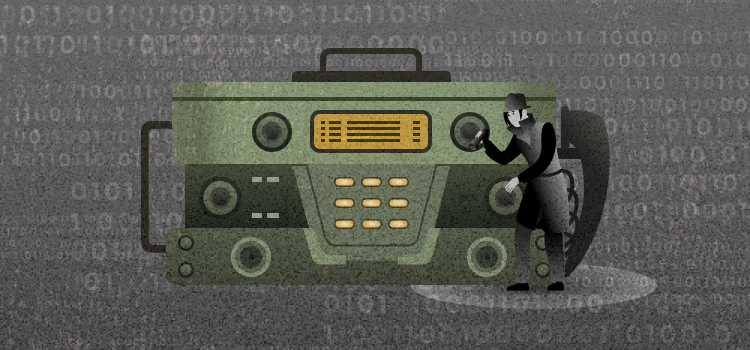February 24, 2023
A History of OSINT: From Informing Spies to Detecting Lies

Steve Adams
Product Marketing Manager
Open-source intelligence (OSINT) has a long and storied history. From early forms of espionage to modern-day social media investigations, OSINT has played a crucial role in the way organizations gather information to meet certain objectives.
Today, OSINT is a rapidly growing field that can be generally defined as the process of collecting, evaluating, and analyzing publicly available information. In the digital age, OSINT tends to refer to data collection using the internet, however, it can also involve other sources like books, journals, newspapers, and government data.
OSINT processes and techniques have revolutionized how businesses, government agencies, law enforcement agencies, and other organizations process critical information and make informed decisions. To understand the field’s future, it’s important to grasp its history and evolution—so, how did it develop into what it is today?
The Origins of OSINT
OSINT’s origins can be traced back to early military settings, where the process was used for espionage and strategic intelligence gathering. Data sources often included newspapers, journals, press clippings, and radio broadcasts, all of which are still used by militaries around the world today.
During World War II, US Allies pored over German newspapers and listened to radio broadcasts in search of valuable information. The US Office of Strategic Services (the precursor to the CIA), the US Foreign Broadcast Intelligence Service (FBIS), the UK Foreign Research and Press Service (FRPS), and the BBC Monitoring Service all integrated OSINT into their operations as they worked to understand activity in Nazi-held territories. Similarly, during the Cold War, the CIA and KGB both leveraged OSINT to tip the balance of the war in their favor by collecting information about their enemy’s military, political, and economic capabilities.
How OSINT Began to Flourish in the Digital Age
Having emerged as a field in military and government, the digital age transformed OSINT into the powerhouse that it is today. As the sheer amount of information online grew, more industries recognized the potential of, and adopted, OSINT.
In the nascent days of the internet, public data was often limited to sources like web articles and online bulletin boards—but then came the smartphone.
The iPhone first launched in 2007, and by 2008 or 2009, the 3G and the 3GS models came to market, touching off the widespread use of the smartphones that exists today. The internet suddenly became accessible at all times, almost anywhere in the world.
At the same time, social media as we know it was in its infancy. With only 12 million members in 2006, Facebook ballooned to over 150 million users just two years later. The launch of the Facebook app, available on everyone’s brand-new smartphones, meant that users could post regular updates throughout the day.
As people spent increasing amounts of time online, additional sources of information like blogs, forums, news outlets, and other channels began to pop up. Suddenly, information on private individuals around the world was available for anyone to see. Recognizing the strategic value of this data, law enforcement agencies in the US and Europe introduced OSINT into their investigative workflows. Until this point, if an investigator wanted to learn more about the daily habits and personal details of a crime lord, for example, they needed to use surveillance or lean on human intelligence sources. With the internet, however, criminals now had a platform to reveal things about themselves just like everyone else. Social media investigations became safer, cheaper, and easier than more traditional methods.
In 2009, the potential of OSINT was showcased on the global stage. Civil unrest in Iran was growing as citizens were protesting against the regime’s policies. Millions of Iranians coordinated their activities online and encouraged other people to join their movement, the ‘Green Revolution.’
OSINT Today and in the Future
At present, OSINT continues to expand rapidly. Fifteen years ago, an analyst or investigator had to manually collect information through repetitive workflows. Investments in artificial intelligence and machine learning made it possible to achieve intelligence collection for OSINT at scale, and gave rise to a range of new use cases like situational awareness, customer due diligence, people and business investigations, combating misinformation, and executive protection.
The growth of OSINT can be attributed to the vast quantity of public data as well as the emergence of specialized OSINT tools like Skopenow that streamline the OSINT process, making it more efficient and effective.
OSINT is no longer the exclusive domain of the government and military. It is now also used by security teams to manage threats to their organization, and by businesses to monitor market trends and consumer behavior. Investigators around the world working in private investigation, insurance, finance, healthcare, journalism, and more rely on the power of OSINT to inform decision-making.
In fact, despite having its origins in the military and government, the US Intelligence Community has been reluctant to fully embrace OSINT over the last few decades. While the CIA has a dedicated Open Source Enterprise (OSE), senior officials have more often prioritized traditional closed intelligence methods, such as human sources, deeming them more reliable. With foreign nations like China fully embracing OSINT, some areas of the US government are falling behind. This is why the government is now investing in OSINT development with initiatives like the Digital Hammer program while increasing the use of OSINT by the Department of State's intelligence bureau to support US diplomacy.
This field has clearly come a long way since its inception. OSINT is now a critical tool for businesses, government agencies, financial institutions, insurance carriers, and other organizations to generate mission-critical intelligence and make informed decisions. With the increasing availability of data and the continued evolution of technology, the future of OSINT is full of possibilities, but challenges exist. OSINT practitioners, for example, cannot feasibly keep up with the sheer amount of information available on the internet without support.
Automation can level the playing field.
At Skopenow, we understand the importance of staying up-to-date on the latest developments, trends, and techniques in OSINT. Our solutions empower organizations to more effectively and efficiently gather and analyze open-source information, identify trends and patterns in the data, and detect emerging threats and fraud. Start unlocking the power of open-source intelligence with a free trial today: www.skopenow.com/try.


